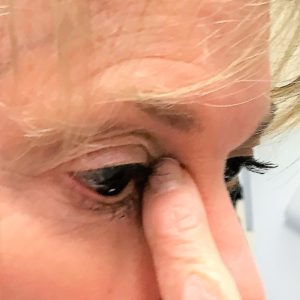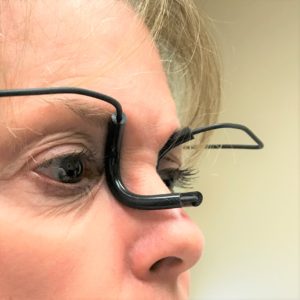Important Message:
Your doctor may have recommended you to use your fingers to press against your tear ducts while putting eyedrops, especially glaucoma eyedrops, but are you sure that you are pressing the right spot or you still can taste bitter eyedrops meds in your mouth? Here’s the solution!
Steps for Putting Glaucoma Eyedrops
- Start by tilting your head backward. With your index finger, gently pull down the lower lid to form a pocket.
- Gently press on your tear ducts with your index finger and thumb (to prevent drops from draining into your throat to cause adverse systemic effects, such as bad aftertaste and/or decreased pulse rate.)*
- Look up. Squeeze one drop into the pocket.
- Close your eyes and keep pressing tear ducts for 5 minutes.
*If you prefer not to use fingers to press tear ducts, we recommend you to use FDA approved Tear Duct OccluderTM while putting drops.
Using Finger to Press Tear Ducts …
 The patient on the left used to use her finger to press against her tear duct while administering drops but her IOP was still not low enough and she was due for glaucoma surgery. Our clinical study shows only 10% of glaucoma patients practice Standard of Care NLO correctly; 14% patients practice it for less than a minute; 14% patients do not practice it regularly and 62% do not practice at all. One of the complains is that patients could not accurately position their fingers on the nasolacrimal ducts.
The patient on the left used to use her finger to press against her tear duct while administering drops but her IOP was still not low enough and she was due for glaucoma surgery. Our clinical study shows only 10% of glaucoma patients practice Standard of Care NLO correctly; 14% patients practice it for less than a minute; 14% patients do not practice it regularly and 62% do not practice at all. One of the complains is that patients could not accurately position their fingers on the nasolacrimal ducts.
Using FDA Approved Device to Press Tear Ducts …
 Tear Duct Occluder(R) sits across your tear ducts firmly and positively to occlude both tear ducts for you while you are administering eyedrops. It eliminates the burden of pressing the tear duct by hand and give you freedom to do other things. It increases your adherence to practicing Tear Duct Occlusion as your doctor advised and therefore, improves your eye healthcare. You simply wear this device while instilling the eyedrops and continue wearing it for 5 more minutes after the instillation. Repeat this process for additional eyedrops, if any. Our clinical data shows that Tear Duct Occluder fits 90% of patients without needing adjustment; 90% of glaucoma patients have high interest on this device; 10% of patients have moderate interest on this device and 10% of all patients do away with surgery.
Tear Duct Occluder(R) sits across your tear ducts firmly and positively to occlude both tear ducts for you while you are administering eyedrops. It eliminates the burden of pressing the tear duct by hand and give you freedom to do other things. It increases your adherence to practicing Tear Duct Occlusion as your doctor advised and therefore, improves your eye healthcare. You simply wear this device while instilling the eyedrops and continue wearing it for 5 more minutes after the instillation. Repeat this process for additional eyedrops, if any. Our clinical data shows that Tear Duct Occluder fits 90% of patients without needing adjustment; 90% of glaucoma patients have high interest on this device; 10% of patients have moderate interest on this device and 10% of all patients do away with surgery.
After using Tear Duct Occluder for two months, this patient’s IOP became low enough to postpone her glaucoma surgery.

